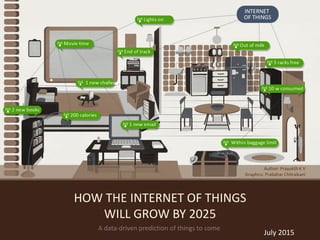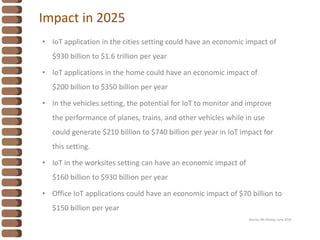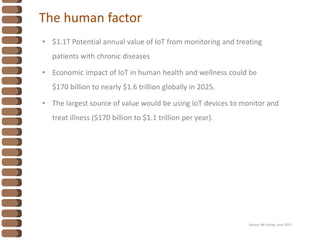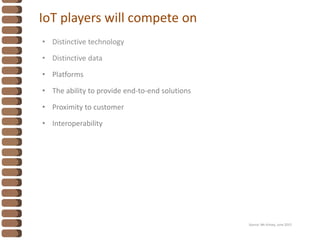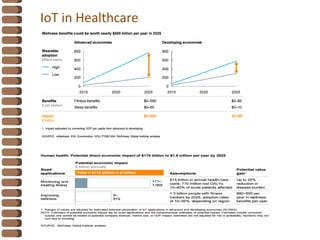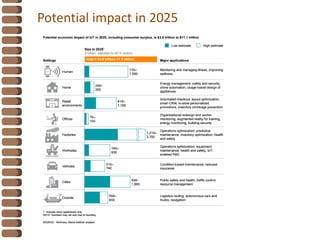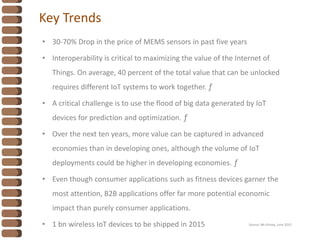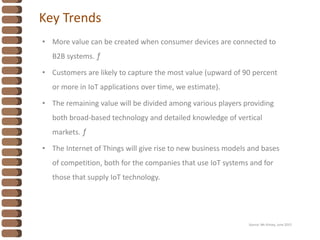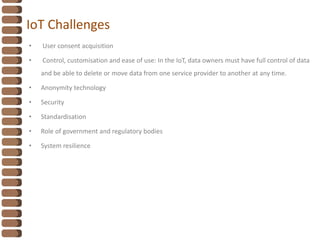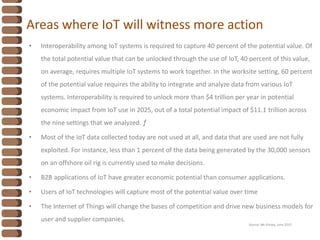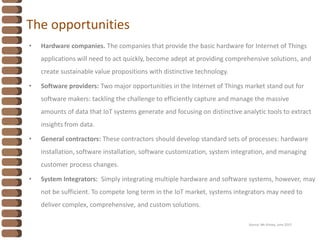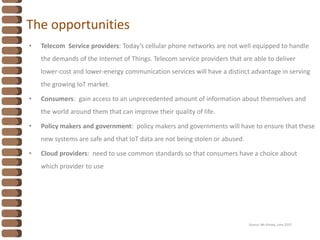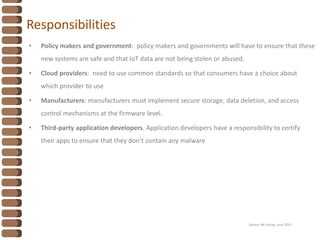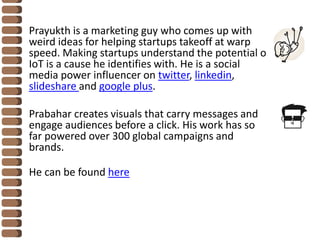How the internet of things is shaping up
- 1. HOW THE INTERNET OF THINGS WILL GROW BY 2025 A data-driven prediction of things to come Author: Prayukth K V Graphics: Prabahar Chitraikani July 2015
- 2. Impact in 2025 • IoT application in the cities setting could have an economic impact of $930 billion to $1.6 trillion per year • IoT applications in the home could have an economic impact of $200 billion to $350 billion per year • In the vehicles setting, the potential for IoT to monitor and improve the performance of planes, trains, and other vehicles while in use could generate $210 billion to $740 billion per year in IoT impact for this setting. • IoT in the worksites setting can have an economic impact of $160 billion to $930 billion per year • Office IoT applications could have an economic impact of $70 billion to $150 billion per year Source: Mc Kinsey, June 2015
- 3. The human factor • $1.1T Potential annual value of IoT from monitoring and treating patients with chronic diseases • Economic impact of IoT in human health and wellness could be $170 billion to nearly $1.6 trillion globally in 2025. • The largest source of value would be using IoT devices to monitor and treat illness ($170 billion to $1.1 trillion per year). Source: Mc Kinsey, June 2015
- 4. IoT players will compete on • Distinctive technology • Distinctive data • Platforms • The ability to provide end-to-end solutions • Proximity to customer • Interoperability Source: Mc Kinsey, June 2015
- 6. Potential impact in 2025
- 7. Key Trends • 30-70% Drop in the price of MEMS sensors in past five years • Interoperability is critical to maximizing the value of the Internet of Things. On average, 40 percent of the total value that can be unlocked requires different IoT systems to work together. ƒ • A critical challenge is to use the flood of big data generated by IoT devices for prediction and optimization. ƒ • Over the next ten years, more value can be captured in advanced economies than in developing ones, although the volume of IoT deployments could be higher in developing economies. ƒ • Even though consumer applications such as fitness devices garner the most attention, B2B applications offer far more potential economic impact than purely consumer applications. • 1 bn wireless IoT devices to be shipped in 2015 Source: Mc Kinsey, June 2015
- 8. Key Trends • More value can be created when consumer devices are connected to B2B systems. ƒ • Customers are likely to capture the most value (upward of 90 percent or more in IoT applications over time, we estimate). • The remaining value will be divided among various players providing both broad-based technology and detailed knowledge of vertical markets. ƒ • The Internet of Things will give rise to new business models and bases of competition, both for the companies that use IoT systems and for those that supply IoT technology. Source: Mc Kinsey, June 2015
- 9. IoT Challenges • User consent acquisition • Control, customisation and ease of use: In the IoT, data owners must have full control of data and be able to delete or move data from one service provider to another at any time. • Anonymity technology • Security • Standardisation • Role of government and regulatory bodies • System resilience
- 10. Areas where IoT will witness more action • Interoperability among IoT systems is required to capture 40 percent of the potential value. Of the total potential value that can be unlocked through the use of IoT, 40 percent of this value, on average, requires multiple IoT systems to work together. In the worksite setting, 60 percent of the potential value requires the ability to integrate and analyze data from various IoT systems. Interoperability is required to unlock more than $4 trillion per year in potential economic impact from IoT use in 2025, out of a total potential impact of $11.1 trillion across the nine settings that we analyzed. ƒ • Most of the IoT data collected today are not used at all, and data that are used are not fully exploited. For instance, less than 1 percent of the data being generated by the 30,000 sensors on an offshore oil rig is currently used to make decisions. • B2B applications of IoT have greater economic potential than consumer applications. • Users of IoT technologies will capture most of the potential value over time • The Internet of Things will change the bases of competition and drive new business models for user and supplier companies. Source: Mc Kinsey, June 2015
- 11. The opportunities • Hardware companies. The companies that provide the basic hardware for Internet of Things applications will need to act quickly, become adept at providing comprehensive solutions, and create sustainable value propositions with distinctive technology. • Software providers: Two major opportunities in the Internet of Things market stand out for software makers: tackling the challenge to efficiently capture and manage the massive amounts of data that IoT systems generate and focusing on distinctive analytic tools to extract insights from data. • General contractors: These contractors should develop standard sets of processes: hardware installation, software installation, software customization, system integration, and managing customer process changes. • System Integrators: Simply integrating multiple hardware and software systems, however, may not be sufficient. To compete long term in the IoT market, systems integrators may need to deliver complex, comprehensive, and custom solutions. Source: Mc Kinsey, June 2015
- 12. The opportunities • Telecom Service providers: Today’s cellular phone networks are not well equipped to handle the demands of the Internet of Things. Telecom service providers that are able to deliver lower-cost and lower-energy communication services will have a distinct advantage in serving the growing IoT market. • Consumers: gain access to an unprecedented amount of information about themselves and the world around them that can improve their quality of life. • Policy makers and government: policy makers and governments will have to ensure that these new systems are safe and that IoT data are not being stolen or abused. • Cloud providers: need to use common standards so that consumers have a choice about which provider to use Source: Mc Kinsey, June 2015
- 13. Responsibilities • Policy makers and government: policy makers and governments will have to ensure that these new systems are safe and that IoT data are not being stolen or abused. • Cloud providers: need to use common standards so that consumers have a choice about which provider to use • Manufacturers: manufacturers must implement secure storage, data deletion, and access control mechanisms at the firmware level. • Third-party application developers. Application developers have a responsibility to certify their apps to ensure that they don’t contain any malware Source: Mc Kinsey, June 2015
- 14. Prayukth is a marketing guy who comes up with weird ideas for helping startups takeoff at warp speed. Making startups understand the potential of IoT is a cause he identifies with. He is a social media power influencer on twitter, linkedin, slideshare and google plus. Prabahar creates visuals that carry messages and engage audiences before a click. His work has so far powered over 300 global campaigns and brands. He can be found here

